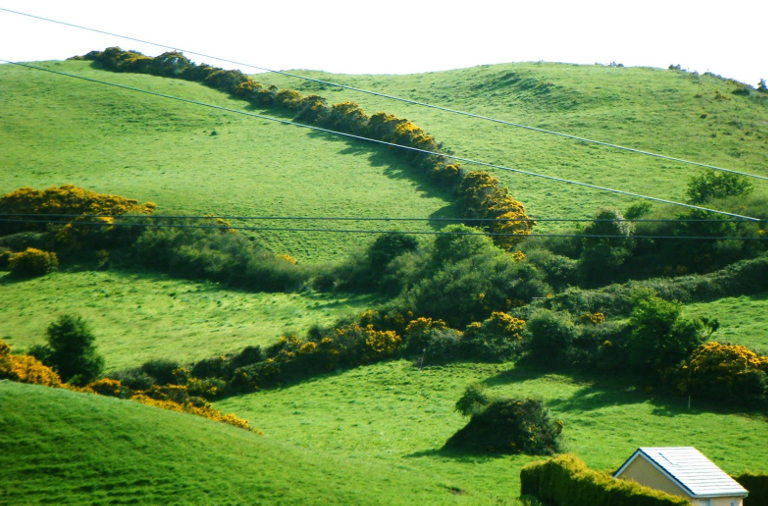 |
| Spider-webs along my neighbour’s hedge |
On these last brilliant autumn days, the hedgerows are giving up the last of their fruits to the birds and local foragers. Red haws cluster so thickly on the branches now that that they droop over the fields, on branches so thin that they wobble even when tiny birds like hawfinches and thrushes land to fatten up for winter.
When they pick one, other more overripe haws dropped from the branches to the grass below, which rustled in response – mice or voles, I supposed, waiting for treats like dogs under the table.
Sloes still cling tightly to their thorny branches, and the final rose-hips dot the vines that wind their way up the trunks. Ours are tiny, wild rose-hips, evolved to suit birds and not human foragers, but on my way to work I pass a community garden with rose-hips the size of figs. I’d love to find out what variety it is and plant some around us for making jam next autumn – roses are pretty and all, but my tastes run to the practical.
I wondered why a garden in the grimy brewery district of Dublin was doing so well, and then I realised – it’s around the corner from where rows of horse-drawn carriages line up to take tourists around Dublin. Some afternoons I see locals eagerly scooping up the manure and bringing it back to their plot, sometimes in two giant bags hanging from their bicycle handles.
Recently I visited my neighbour down the road, an old man who has lived in the area all his life, and who shows me the local castles and graveyards here and talks about the history of all the local families. On the day of our first frost, I knocked on his door to return a book, and I asked him what kind of winter he expected.
“A harsh one, I think,” he said. “We’ve had a hot summer, and we often get a harsh winter after that – as we did last year, with a metre of snow. You can’t really say anymore these days,” he added, noting that the weather was less predictable than it used to be.
We talked a bit about the hedgerows, and I noted how many Americans didn’t have them – we all divided our properties with chain-link fences that rusted, didn’t cut the wind, and didn’t offer privacy or food.
“People are tearing them down here too,” my neighbour said. “It’s a shame – when we plant fields, we need the border to make the field work.” He explained how their fruit brings birds that fertilise the fields, they keep soil from escaping the field after a rain, and their hardy trees and wild plants soak up whatever farmers spray on the crops.
 |
| Hedges along the hills in summer |
That’s interesting, I said – that the wild borders were necessary for the field to thrive. The Old Testament repeats over and over that people are not to cut the edges of their land, and were always to leave some of the crops left over – in Leviticus 19:9, for example. It was supposed to be for gleaners and people who were poor, but I wonder if part of the reason, consciously or unconsciously, was to also give some of it back to Nature. How do most farmers here feel about these things?
“It depends on the farmer,” he said. “I was talking to a neighbour here who decided to go organic. He had spread pesticides over the fields every year, but he would come out and see it covered in dead worms afterwards. He decided it wasn’t worth it anymore.”
I’ll be interested to hear how he gets on, I said. Although pesticides aren’t exactly new here — are the dead worms a new phenomenon? I wonder if his pesticide changed. I had read a study last year that found that tillage agriculture was harming worm populations, but I’m not sure if changing to organic would help that.
I also find it interesting that no birds had snapped up the dead worms – I was hearing someone the other day say that they remember as a child seeing flocks of birds follow their tractor around after ploughing, but now they don’t.
“That’s interesting,” he said. “I’ve noticed that birds used to follow the cows around less than they used to.”
All this is anecdotal evidence, I said, but I’d like to see some real data on this. I know that the number of insects around Europe has plummeted, but no one’s sure why — and they’re close to the base of the food chain.
“What everyone used to do whenever they could was to let ground rest for a while after growing things on it, or let cows graze on it,” he told me. “That did the same thing the hedgerows do. The local landowner here, around a hundred years ago, used to grow the best potatoes of anyone, as he would grow them only on land that had been fallow the previous year. Of course, that was because he had the extra land to do that.”
I often see that today, I said – upper-class people will do well, and think it was all their own hard work. They might indeed have worked hard, but people don’t see their own advantages.
| Our hedge in winter |
It made sense to me that that letting land “rest” would help rejuvenate it; in the wild, a plot of barren land will quickly be covered by a profusion of different species, which cover the ground, protect it from erosion by rain, bloom with many different flowers, bring many different pollinators, which feed different birds. They each bear different fruit or seeds, and many bring in their own fungus or bacteria colonies with their roots. As the plants and small critters spread across the surface of the soil, much more is growing under it – from mushroom colonies to worms to tens of thousands of species of tiny beasts, from miniature to microscopic – and once living things have done their job, they turn them into soil again. In other words, the living system takes the depleted funds of the soil and rebuilds a rich credit account of nutrients, before we make a withdrawal and turn it into another round of crops for ourselves.
I suppose most people just had a small plot, and only grew potatoes? I asked.
“They had to,” he said. “Each person had so little land for themselves, and nothing else would feed them all the time but potatoes. But it meant you had to grow the same crops on the same land, over and over, and never gave the land a rest. Nothing but the same plants tires out the land, taking the same minerals from it year after year, and tires ground makes the plants sickly. I know the blight was the main reason for the Famine, but I can’t help but think that tiring out the land didn’t help.”
 |
| Tree along the canal near our house |
That’s an interesting point, I said. I told him about the essay by Ugo Bardi some years ago, determining that soil erosion made the Famine worse: After Britain conquered Ireland, its trees went to make up London’s buildings and Britain’s fleet, and soil erosion took its toll on the deforested land. I also told him that in America, there are vast areas where people only grow corn, or wheat, year after year.
“I think we had the Famine because we pushed our land to its limit,” my neighbour said. “And I think we’re doing it again.”






